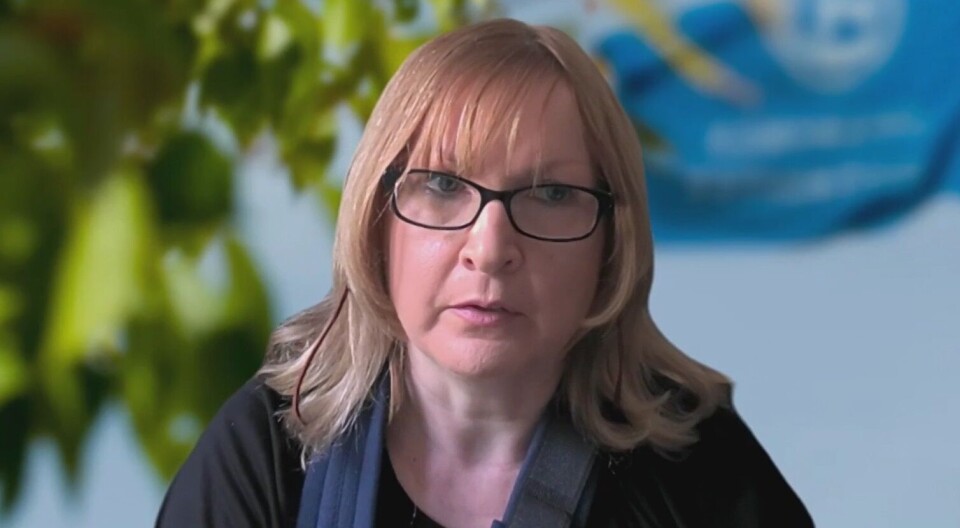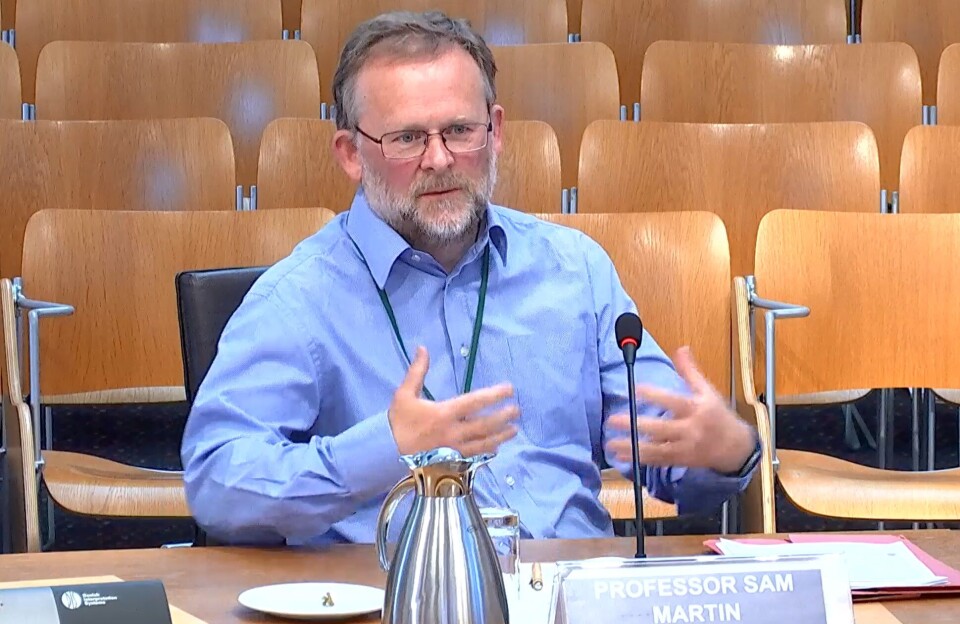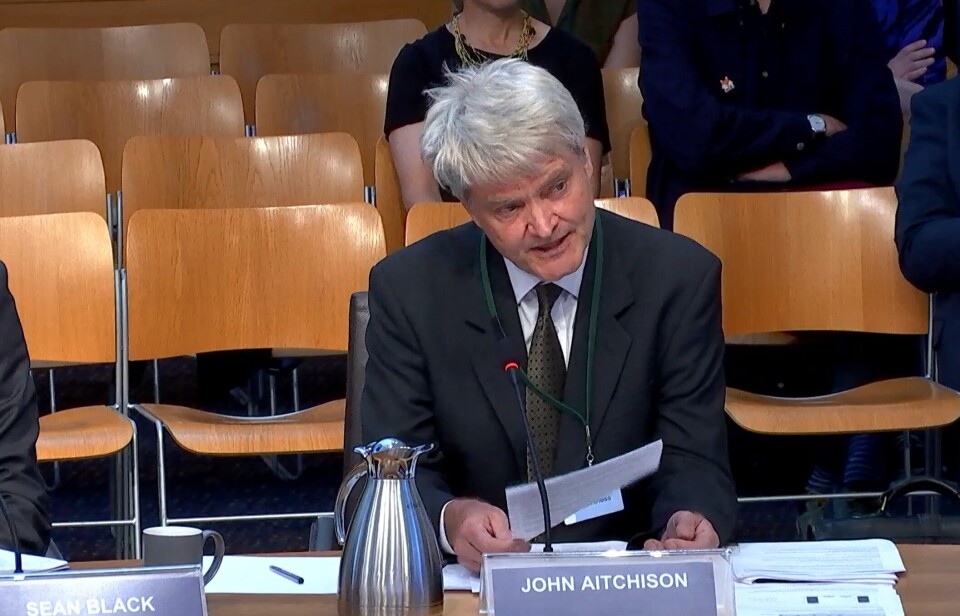
Fish pain expert repeats call for ban on thermal delousing treatments
MSPs told that water temperature can be above salmon pain threshold
A scientist whose work helped prove that fish feel pain has repeated a call for salmon farmers to be banned from using thermal delousing.
Professor Lynne Sneddon, of the University of Gothenburg, was giving evidence yesterday by video link to the Scottish Parliament’s Rural Affairs and Islands (RAI) Committee, which wants to know what progress has been made to implement recommendations made after an inquiry into the Scottish salmon farming sector in 2018.
Sneddon, who was the first to characterise nociceptors that detect painful stimuli on the head of a fish, criticised the use of lice bath treatments and also mechanical methods, which she said entailed “swimming the fish backwards through jets of water so you knock the sea lice off”.
“You must remember that the fish pain receptors are sensitive to less than 0.1 gram, and so swimming them backwards through jets of water is likely to be painful,” said Sneddon.
Above the pain threshold
“The other option is the thermolicer that uses high temperatures, so you’re effectively putting the fish into temperatures that scald the skin and the sea lice don’t like it and they drop off. Those temperatures that are used are above the threshold for pain in salmon, so we’re looking at temperatures above 29°C.
“I wrote to the Scottish Parliament, the animal welfare committee and to RSPCA Assured to point this out in 2019, to say that this treatment actually causes pain to the animals. Having spoken to people in the industry, these animals don’t feed for several weeks afterwards, so they are in effect weakened or in a poor welfare state. We just shouldn’t be allowing that kind of treatment to be applied to the animals and it significantly impairs their behaviour, their welfare.”
Feeding the next day
Fish Farming Expert understands that thermal delousers in Scotland operate at up to 20°C above the ambient temperature of the sea water and use a maximum water temperature of 34°C. The salmon are exposed to the warm water for 30 seconds, and begin feeding the day after treatment.
One farmer contacted by FFE after Sneddon gave evidence said its most recent thermal treatment was of large fish and the treatment water was at 29.2°C, which was 17.7 °C above ambient. The treatment removed 93% of all lice stages and there was very low mortality post treatment.

Underlying conditions
Professor Sam Martin, director of research at the School of Biological Sciences, University of Aberdeen, told the RAI Committee that if fish were already compromised biologically, they couldn’t deal so well with physical treatments that required moving them into a wellboat. “I wouldn’t think that the actual lice treatments themselves are compromising them much, but if they have other underlying conditions these treatments may exacerbate what’s going on.”
Martin said he had been involved in a project looking at the effects of thermal delousing on fish, although his area of research had been gills, not pain. “From the welfare indicators we used, it didn’t seem that there was anything negative happening, but it doesn’t mean it’s perfect, at all,” he said.

Professor Simon MacKenzie, head of the Institute of Aquaculture at Stirling University, said: “The evidence is very clear that [water temperature] over 29 degrees is beyond the pain threshold of salmon. Current information is a little bit fragmented but in Norway they’re saying that if there’s enough evidence, they’ll stop that form of treatment. Thermolicer at the moment is the most used technique, although there are multiple different mechanical techniques, and the industry is using combinations.
Temperature-shocking
“There is a series of different things here, one of them is a very specific methodology called thermolicer which is the ‘temperature-shocking’ space, and there are definitely a series of ethical issues around that one, and then there’s other mechanical treatments or combinations of them.
“If you look at mortalities in that space, and the burden of disease, the key story is when can you do it and when you can not do it. The body of evidence in science right now is that it’s very difficult to measure when you can do that, and you cannot. That is what is causing the threshold problem, there’s a real issue there, and I think across the scientific community most of research is aiming towards that space and trying to understand how it operates within the animals.”
Scientists Dr Helena Reinardy, lecturer and teaching fellow at the Scottish Association for Marine Science (SAMS), and Dr Annette Boerlage, research fellow in Aquatic Epidemiology, School of Veterinary Medicine, Scotland’s Rural College, also gave evidence yesterday.

Earlier, committee members took evidence from non-governmental organisations.
Opening the meeting, convenor Finley Carson pointed out that salmon farming was worth £760 million to the Scottish economy in 2021 and provides over 1,500 full-time jobs and asked if the NGOs thought the sector brought economic and social benefits to Scotland.
'No place in the future'
Rachel Mulrenan, Scotland director for angling pressure group WildFish (formerly Salmon and Trout Conservation) replied: “We obviously recognise the need for high quality, future-proof jobs on the west coast of the Highlands and Islands, and that’s beyond dispute, but we do not think at Wild Fish that salmon farming has a place in this future.”
She claimed the sector had created only 465 out of the 22,100 new jobs added across the Highlands and Islands over the last 30 years.
Sean Black, senior scientific officer for aquaculture for the RSPCA, and Sarah Evans, aquaculture policy officer for the Marine Conservation Society, said their organisations didn’t take a position on the issue, although when Carson said that the sector’s £66 million positive impact and employment contribution was “not to be sniffed at in a rural area”, Evans said: “I would agree with that.”

John Aitchison, a member of the Coastal Communities Network that wants salmon farming moved on to land, said: “There are jobs in salmon farms, they are important, all jobs are important, but jobs don’t depend on how the salmon farming’s done. So, if the salmon was done better, the jobs would still be there; if it’s done even better there could be more jobs.”
He pointed out that automation is happening, farms are consolidating into bigger units, and there are an average of seven jobs per farm.
He said permitted biomass had grown by 50,000 tonnes since the 2018 inquiry report, despite mortality worsening, and that approximately 50,000 tonnes more had been applied for. Aitchison also claimed that the sea off Argyll, where he lives, had become too warm for salmon farming because the winter temperature was no longer low enough to reduce numbers of organisms that challenge salmon health.
The RAI Committee has three more evidence sessions this month and resumes its inquiry in September after the Scottish Parliament’s summer recess.
The timetable is:
- 12 June: Evidence on farmed fish health; Evidence from the Scottish Environmental Protection Agency
- 19 June: Evidence on licensing and consenting issues
- 26 June: Evidence from the Salmon Interactions Working Group
- 22 to 23 September: Committee visit to a salmon farm
- 25 September: Evidence from salmon farming industry representatives
- 2 October: Industry roundtable
- 9 October: Evidence from the Cabinet Secretary for Rural Affairs, Land Reform and Islands, Mairi Gougeon























































